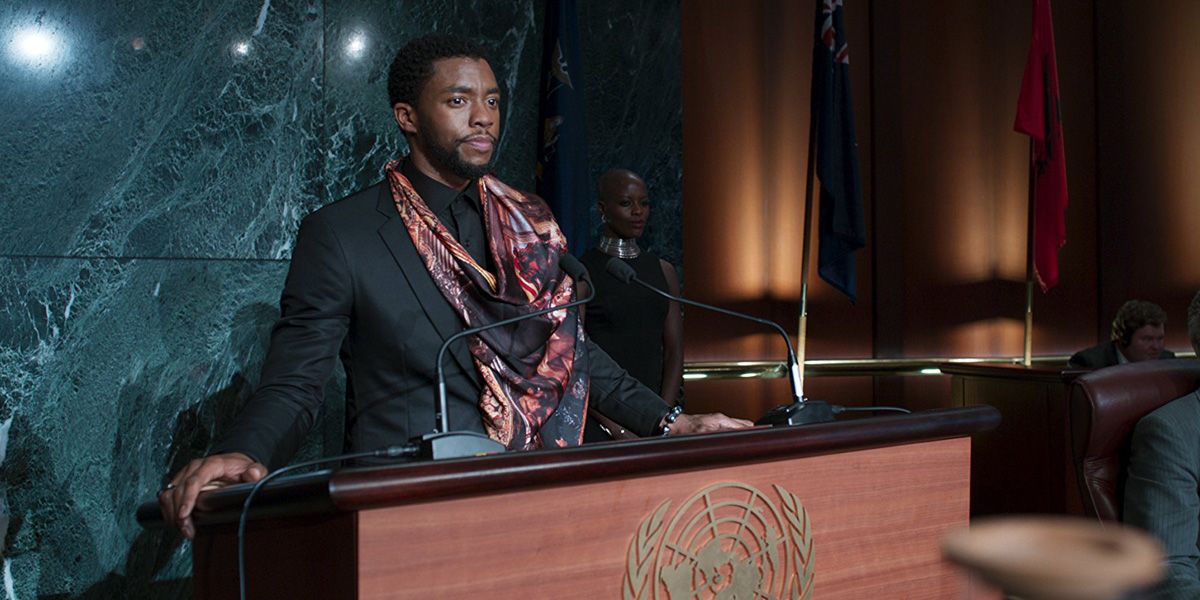WARNING: The following article contains spoilers for Marvel's Black Panther, in theaters now.
Black Panther director Ryan Coogler has revealed he originally had a different ending in mind for Marvel's latest blockbuster -- one that still made its way into the final film.
The movie ends with T'Challa and Shuri heading to the apartment in Oakland, California, in which their father killed Erik Killmonger's father, and reflecting on how they came to be in the civil war of Wakanda. However, that apparently wasn't how Coogler initially wanted to end the story. He instead intended the United Nations scene, which ultimately became the mid-credits sequence, to close out the film.
RELATED: Black Panther’s Dramatic Ending, Explained
Speaking with Empire Film Podcast, Coogler confessed that seeing T'Challa take the stage among the rest of the world's powers was how he wanted to leave Black Panther.
“It was [almost the ending]. We played with a lot of different ways to end it," he said. "We went back and forth about the U.N., and we had a version where it was the U.N. before the scenes in Oakland at the end. But we really kind of settled on how do we want the movie to end? And it came back to that symmetry, and it came back to the most moving version of it. That’s what we were asking ourselves, ‘Who’s more moved emotionally, that kid or the people sitting in the U.N.?’ Who is that a bigger deal to for T’Challa to walk in, who’s more connected to him?”
Remembering what came after Oakland, the mid-credits featured T'Challa alongside his friends at the U.N. as they decided to share Wakanda's technology with the rest of the world. With the likes of Danai Gurira's Okoye and Lupita Nyong’o's Nakia also playing a part, it flowed on from the previous shot without rehashing what came before it. Continuing with Empire, Coogler discussed how he settled on the Oakland ending instead.
RELATED: How Marvel’s Black Panther Sets Up a Sequel
“As a kid, growing up, when you see somebody who looks like an older version of you doing something awesome, it’s like, ‘What’s going on?’" he said. "That’s kind of what that moment. … We kind of went with the less distilled emotion, and the U.N. makes sense afterwards for where Wakanda could be going in the future of this universe.”
Logan's James Mangold may have strong feelings about the use of post-credit scenes, but since Nick Fury's appearance in 2008's Iron Man, the Marvel Cinematic Universe has become synonymous in teasing what could come next. Remember that after the U.N. sequence there is also a post-credits scene that defrosted Bucky Barnes.
By settling on the Oakland ending, Coogler also gave Black Panther more of a standalone feel before we got to the follow-up scenes. Black Panther could've easily used the U.N. as the finale, but returning to Oakland to see Wakanda's first outreach program gives fans more of an emotional attachment.
Now in theaters, director Ryan Coogler’s Black Panther stars Chadwick Boseman as T’Challa/Black Panther, Michael B. Jordan as N’Jadaka/Erik “Killmonger” Stevens, Lupita Nyong’o as Nakia, Danai Gurira as Okoye, Martin Freeman as Everett K. Ross, Daniel Kaluuya as W’Kabi, Letitia Wright as Shuri, Winston Duke as M’Baku, Angela Bassett as Ramonda, Forest Whitaker as Zuri and Andy Serkis as Ulysses Klaue.
(via Collider)

